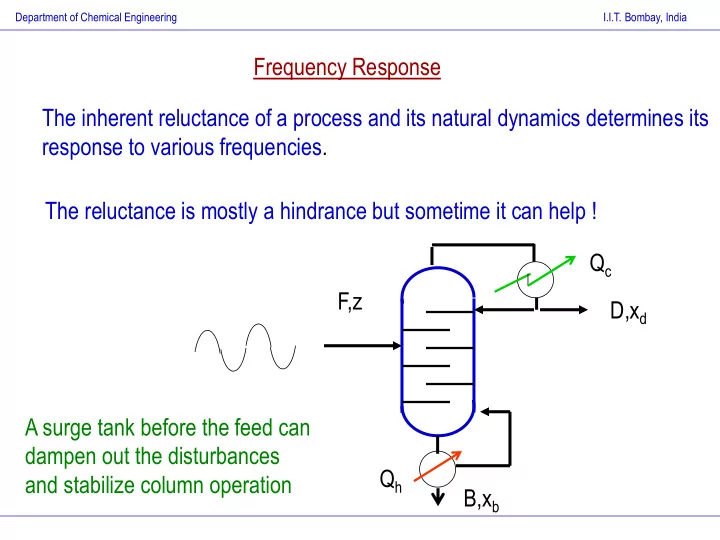

Department of Chemical Engineering I.I.T. Bombay, India Frequency Response The inherent reluctance of a process and its natural dynamics determines its response to various frequencies. The reluctance is mostly a hindrance but sometime it can help ! Q c F,z D,x d A surge tank before the feed can dampen out the disturbances Q h and stabilize column operation B,x b
Department of Chemical Engineering I.I.T. Bombay, India Analysis of Dynamics via frequency response W=0.1 rad/sec W=1 rad/sec W=5 rad/sec
Department of Chemical Engineering I.I.T. Bombay, India Frequency Response Generation Process Transfer function y ( s ) G ( s ) ( ) u s Input signal w s u(t) = sin ( w t) u ( s ) w 2 2 w ( ) ( ) y s G s 2 2 s w And then invert this in the time domain to get the frequency response.
Department of Chemical Engineering I.I.T. Bombay, India Basic Complex Algebra Given a complex number z=a+ j b, it can be represented in the complex plane as shown below. Im. axis b Real axis a Magnitude of z denoted by |z|= (a 2 +b 2 ) 0.5 and angle is tan -1 (b/a) and z can be more compactly represented as z=|z| e j
Department of Chemical Engineering I.I.T. Bombay, India Short cut Method for Frequency Response Generation Step 1: s=jw in G(s) to obtain G(jw) Step 2: Rationalize G(jw) to obtain Real and imaginary parts Step 3: The output sine wave will have an amplitude A out =A (Real 2 + Imag 2 ) and the phase angle is =tan -1 ( Imag/ Real). Illustrative example 1 jw 1 G ( jw ) s G ( s ) 1 1
Department of Chemical Engineering I.I.T. Bombay, India Short cut Method for Frequency Response Generation 1 1 jw jw G ( jw ) 2 2 2 2 2 2 w 1 w 1 w 1 1 w Re( ) and Im( ) jw jw 2 2 2 2 1 1 w w Output Amplitude is therefore 1 2 2 1 w 2 2 1 2 2 2 2 w w 1 w 1 Phase is therefore tan 1 ( w )
Department of Chemical Engineering I.I.T. Bombay, India Representation of Frequency Response Information Bode Plots: Plot the amplitude ratio (AR) and the phase lag on two separate plots called the Magnitude and the phase plots. For the illustrative example, Magnitude plots are typically logarithmic but phase plots are semi-logarithmic.
Department of Chemical Engineering I.I.T. Bombay, India Representation of Frequency Response Information Nyquist Plots: Plot the amplitude ratio (AR) and the phase lag on the same plot in the imaginary plane.Treat G(jw) as a complex number and plot the Real(G) and Imag(G) on the diagram. Note: Unlike the bode plot, the phase angle is implicit in the plot here.
Department of Chemical Engineering I.I.T. Bombay, India Frequency Response of several systems in series If g(s) = g 1 (s)g 2 (s)g 3 (s) … g N (s), then they can all be expressed in the frequency domain as g(jw)=g 1 (jw)g 2 (jw)g 3 (jw) … g N (jw) Using the polar form of representation g(jw)=|g 1 ||g 2 ||g 3 ||g 4 | …. |g N | e j , where , is the summation of the individual phase angles. Thus, the bode plots of higher order systems can be constructed from the local building blocks.
Department of Chemical Engineering I.I.T. Bombay, India General behaviour of the frequency response plots The amplitude ratio plots generally decay at higher frequencies, more so for chemical processes. The rate of decay is a function of the order of the process. The phase plot asymptotically approaches (p-q) times – 90 o at high frequencies, where p is the number of poles and q is the number of zeros. Can you guess why ? Also, what is the frequency response of a pure delay process ?
Department of Chemical Engineering I.I.T. Bombay, India Pure Lead System: Frequency Response ( ) ( 1 ) , G s K s G ( jw ) K ( jw 1 ) 2 2 AR K 1 w , 1 tan ( w )
Recommend
More recommend